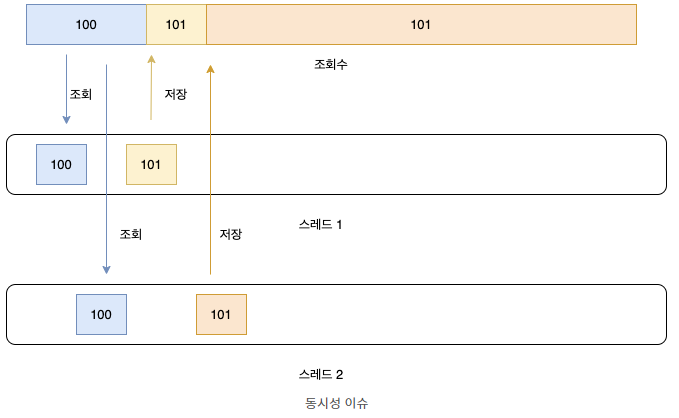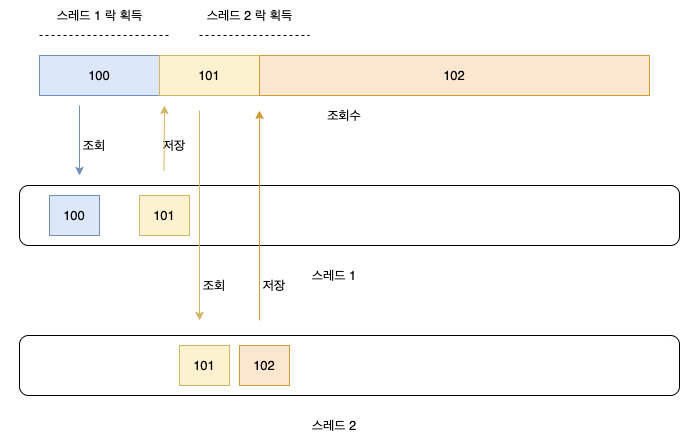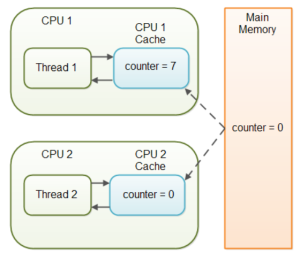##스레드란
- 프로세스
- 특정 작업을 수행하는 소프트웨어를 프로그램이라고 한다.
- 프로그램이 실제로 실행되어, 메모리나 CPU와 같은 자원을 할당받으면 이를 프로세스라고 부름
- 스레드는 이 프로세스를 구성하는 하나의 단위이다.
하나의 프로세스에는 여러 스레드가 작동하고 있을 수 있다. - 스레드
- 스레드는 작업의 한 단위임
- 프로세스는 독자적인 메모리를 할당받아서 서로 다른 프로세스끼리는 일반적으로 서로의 메모리 영역을 침범하지 못한다.
- 하지만 프로세스 내부에 있는 여러 스레드들은 서로 같은 프로세스 내부에 존재하고 있기 때문에 같은 자원을 공유하여 사용할 수 있다.
- 같은 자원을 공유할 수 있기 때문에 동시에 여러 가지 일을 같은 자원을 두고 수행할 수 있고, 이는 곧 병렬성의 향상으로 이어진다.
- 여러 스레드가 동시에 하나의 자원을 공유하고 있기 때문에 이 자원을 두고 여러 가지 문제점이 발생할 수 있다.
- 동시성 문제, 데드락과 같은 여러 가지 문제점을 해결해야 멀티스레드 환경에서 문제없는 프로그램을 제작할 수 있다.
##스레드 안정성이 깨지는 상황
- 조회수 계산 프로그램
-
100명의 스레드로 각각 100번 조회했을 때
public class CountingTest { public static void main(String[] args) { Count count = new Count(); for (int i = 0; i < 100; i++) { new Thread(){ public void run(){ for (int j = 0; j < 100; j++) { System.out.println(count.view()); } } }.start(); } } } class Count { private int count; public int view() {return count++;} public int getCount() {return count;} } -
결과 : 10000번이 아닌, 더 적은 조회수가 나옴
-
이유 : 조회수를 증가시키는 로직이 두 번의 동작으로 이루어지는데 동시에 여러 스레드가 접근하여 첫 번째 동작할 때의 자원과 두 번째 동작할 때의 자원
상태가 변하기 때문
2.Count
클래스의 view 메서드는 count++이라는 동작을 진행한다.
count 변수의 값을 조회한다.
조회한 count변수 값에 1을 더한 값을 저장한다.

- 결과
- 이러한 동작들 사이사이에 여러 스레드가 접근하게 되면 동시성 이슈가 발생할 수 있다..
- 여러 스레드에서 동시에 count변수에 접근한다면 동시에 1번 동작을 진행하여 같은 count값을 조회할 것이고,
두 개의 스레드가 1을 더하는 조회 로직을 실행한다고 해도 2가 더해지는 것이 아닌 1만 더해지는 동작이 발생할 수 있다
##동시성을 제어하는 방법 : Lock
- 여러 쓰레드가 write하는 상황일때

- 암시적 Lock : synchronized
: Lock을 건다.
- Lock을 적용하게 되면 하나의 스레드가 해당 메서드를 실행하고 있을 때 다른 메서드가 해당 메서드를 실행하지 못하고 대기하게 된다.
- 즉 한 번에 하나의 스레드만 접근할 수 있게 된다. → 여러 스레드가 동시에 접근할 수 없게 만들어 동시성 이슈를 막을 수 있음
- 단점 : 한 번에 하나의 스레드만 메서드를 실행시킬 수 있으므로 병렬성은 매우 낮아짐
- 문제가 된 view 메서드에 synchronized 키워드를 붙이면 암시적 락이 걸린다.
lock은 메서드, 변수에 각각 걸 수 있다.
- 메서드에 lock을 걸 경우 해당 메서드에 진입하는 스레드는 단 하나만 가능
- 변수에 lock을 걸 경우 해당 변수를 단 하나의 스레드만 참조할 수 있다.
- 단, 변수에 lock을 걸기 위해선 해당 변수는 객체여야 한다. int, long과 같은 기본형 타입에는 lock을 걸 수 없습니다.
1) 메서드 Lock
class Count {
private int count;
public synchronized int view() {return count++;}
}2) 변수 Lock
class Count {
private Integer count = 0;
public int view() {
synchronized (this.count) {
return count++;
}
}
}2.명시적 Lock : ReentrantLock
: synchronized 키워드 없이 명시적으로 ReentrantLock을 사용하는 Lock이다.
- 언제사용? 해당 Lock의 범위를 메서드 내부에서 한정하기 어렵거나, 동시에 여러 Lock을 사용하고 싶을 때 사용
- 직접적으로 Lock 객체를 생성하여 사용할 수 있다.
- lock() : 다른 스레드가 해당 lock() 메서드 시작점에 접근하지 못하고 대기
- unlock() : 다른 메서드가 lock을 획득할 수 있게 된다.
명시적 Lock을 사용한 예제
public class CountingTest {
public static void main(String[] args) {
Count count = new Count();
for (int i = 0; i < 100; i++) {
new Thread(){
public void run(){
for (int j = 0; j < 1000; j++) {
count.getLock().lock();
System.out.println(count.view());
count.getLock().unlock();
}
}
}.start();
}
}
}
class Count {
private int count = 0;
private Lock lock = new ReentrantLock();
public int view() {
return count++;
}
public Lock getLock(){
return lock;
};
}#언제 synchoronized 식별자 사용?
1.하나의 객체에 여러개의 스레드가 접근해서 처리하고자 할때
2.static으로 선언한 객체에 여러 스레드가 동시에 사용할때
- 변수를 공유할땐 static 변수사용, 하지만 static변수는 객체 생성할 수 없음
- Atomic은 기존변수에 동시성 제어를 하는것이 아니라 AtomicType객체를 생성해서 해당 AtomicType객체에 대한 동시성을 제어하는 것이다.
그러므로 새롭게 생성할 수 없는 Static변수나 기존 변수에 동시성을 제어하기 위해선 synchoronized 키워드를 붙여서 사용한다.
##동시성을 제어하는 방법 : Volatile
- volatile은 CPU 캐시 사용 막음 → 메모리에 접근해서 실제 값을 읽어오도록 설정 → 데이터 불일치를 막는다.
- 자원의 가시성을 책임진다
- 메인 메모리에 저장된 실제 자원의 값을 볼 수 있는 것
**자원의 가시성:
- 변수에 저장한 데이터를 읽었는데 이 데이터가 실제 데이터와 차이가 있을 수 있다.
메인 메모리에 저장된 실제 자원의 값을 볼 수 있는 개념을 자원의 가시성이라한다.
#사용상황
- 멀티쓰레드 환경에서 하나의 쓰레드만 read&write하고 나머지 쓰레드가 read하는 상황에 사용
- Read : CPU cache에 저장된 값X , Main Memory에서 읽는다.
- Write : Main Memory에 까지 작성
- 가장 최신의 값 보장
#Java volatile가 필요한 이유?

- 멀티쓰레드 어플리케이션에서 volatile변수 사용 안할때 → Main Memory에서 읽은 변수 값을 CPU Cache에 저장
- 멀티쓰레드 환경에서 쓰레드가 변수값을 읽어올 때 각각의 CPU Cache에 저장된 값이 다르기 때문에 변수 값 불일치 문제가 발생
#Example
SharedObject를 공유하는 두 개의 Thread가 있다
public class SharedObject {
public int counter = 0;
}- Thread-1는 counter 값을 더하고, 읽는 연산 (Read & Write)
- Thread-2는 counter 값을 읽기만(Only Read)
Thread-1은 counter값을 증가시킨다. 하지만 CPU Cache에만 반영, 실제로 Main Memory에는 반영X → Thread-2는 count값으로 0을 가져오는 문제 발생

#해결방법
- volatile 키워드를 추가 → Main Memory에 저장하고 읽어옴 → 변수 값 불일치 문제해결
public class SharedObject {
public volatile int counter = 0;
}#volatile 성능
- volatile는 변수의 read와 write를 Main Memory에서 진행
- CPU Cache보다 Main Memory가 비용이 더 큼 (→ 변수 값 일치를 보장해야 하는 경우 사용 권장)
#정리
- volatile
- Main Memory에 read & write를 보장한다.
- 상황
- 하나의 쓰레드만 read&write하고 나머지 쓰레드가 read하는 상황에 적합
- 변수의 값이 최신의 값으로 읽어와야 하는 경우.
- 성능
- CPU Cache보다 Main Memory가 비용이 더 큼
##동시성을 제어하는 방법 : Atomic
- java.util.concurrent.atomic
- Atomic 클래스는 *CAS(compare-and-swap)를 이용하여 동시성을 보장
- AtomicInteger는 synchronized 보다 적은 비용으로 동시성을 보장
#AtomicInteger 메서드
- addAndGet (int delta) : 주어진 값을 현재 값에 원자 적으로 더합니다.
- compareAndSet (int expect, int update) : 현재 값이 예상 값과 같으면 원자 적으로 값을 지정된 업데이트 된 값으로 설정합니다.
- get () : 현재 값을 가져옵니다.
getAndAdd (int delta) : 주어진 값을 현재 값에 원자 적으로 더합니다. - getAndIncrement () : 현재 값을 원자 적으로 1 씩 증가시킵니다. (현재값 반환 후 1씩 증가)
- incrementAndGet () : 현재 값을 원자 적으로 1 씩 증가시킵니다. (1씩 증가 후 현재값 반환)
- ...
#example
람다식
public class AtomicIntExample {
public static void main(String[] args) {
ExecutorService executor = Executors.newFixedThreadPool(2);
AtomicInteger atomicInt = new AtomicInteger();
for(int i = 0; i < 10; i++){
executor.submit(()->System.out.println("Counter- " + atomicInt.incrementAndGet())); // 1
}
executor.shutdown();
}
}public class AtomicIntExample {
public static void main(String[] args) {
ExecutorService executor = Executors.newFixedThreadPool(2);
AtomicInteger atomicInt = new AtomicInteger();
CounterRunnable runnableTask = new CounterRunnable(atomicInt);
for(int i = 0; i < 10; i++){
executor.submit(runnableTask);
}
executor.shutdown();
}
}
class CounterRunnable implements Runnable{
AtomicInteger atomicInt;
CounterRunnable(AtomicInteger atomicInt){
this.atomicInt = atomicInt;
}
@Override
public void run() {
System.out.println("Counter- " + atomicInt.incrementAndGet());
}
}결과 :
Counter- 1
Counter- 2
Counter- 3
Counter- 4
Counter- 5
Counter- 6
Counter- 7
Counter- 8
Counter- 9
Counter- 10#CAS(Compare And Swap)알고리즘

AtomicInterger를 Decompile 하여 요약한 내용
public class AtomicInteger extends Number implements java.io.Serializable {
private volatile int value;
public final int incrementAndGet() {
int current;
int next;
do {
current = get();
next = current + 1;
} while (!compareAndSet(current, next));
return next;
}
public final boolean compareAndSet(int expect, int update) {
return unsafe.compareAndSwapInt(this, valueOffset, expect, update);
}
}- incrementAndGet() 메소드 내부에서 CAS알고리즘 로직구현
- compareAndSet()의 결과 리턴 받아서 성공할때까지 while문 무한 루프를 돈다.
- compareAndSet() 내부에서는 compareAndSwapInt()를 호출하여 메모리에 저장되어진 값과 현재 CPU캐시에 저장된 expect 값을 비교하여 동일한 경우만 변경하려는 값 update로 쓰기를 수행한다.
- 다른 AtomicInteger 메소드 들도 거의 유사한 패턴으로 구현되어 있다.
- volatile int value; 선언부 인데 voliatile는 변수의 가시성 문제를 해결하기 위해서 사용된다.
- volatile 키워드가 붙어 있는 객체는 CPU캐시가 아닌 메인 메모리에서 값을 참조해온다.
##synchronized, volatile, AtomicInteger 비교
synchronized
- 여러 쓰레드가 write하는 상황에 적합
- 가시성 문제해결 : synchronized블락 진입전 후에 메인 메모리와 CPU 캐시 메모리의 값을 동기화 하기 때문에 문제가 없도록 처리
volatile
- 하나의 쓰레드만 read&write하고 나머지 쓰레드가 read하는 상황에 적합
- 가시성 문제해결 : CPU 캐시 사용 막음 → 메모리에 접근해서 실제 값을 읽어오도록 설정
- Read : CPU cache에 저장된 값X , Main Memory에서 읽는다.
- Write : Main Memory에 까지 작성
AtomicIntger
- 여러 쓰레드가 read&write를 병행
- 가시성 문제해결 : CAS알고리즘
- 현재 쓰레드에 저장된 값과 메인 메모리에 저장된 값을 비교 → 일치시 새로운 값으로 교체, 불일치시 실패하고 재시도
##스레드 안전한 객체 사용
#Concurrent 패키지
- Executor
- ExecutorService
- Future
- Callable
- BlockingQueue
- ...
참조 :
https://dzone.com/articles/java-patterns-for-concurrency
https://deveric.tistory.com/104
https://javaplant.tistory.com/23
